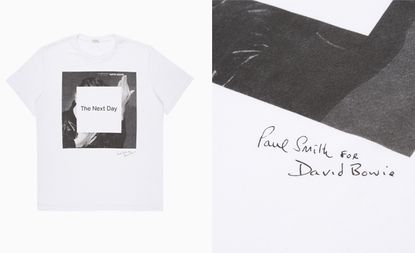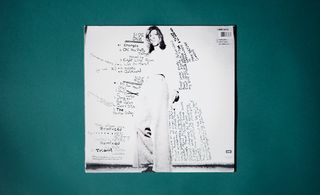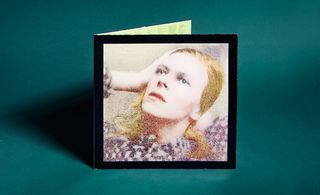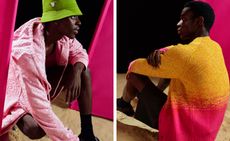Paul Smith designs the official T-Shirt for David Bowie's new album

Few musicians have used art and image to such great effect as David Bowie. Back from a ten-year hiatus with 'The Next Day', his 24th album and a return to collaboration with Tony Visconti, Bowie is once again setting a visual agenda as well as a sonic one.
The Next Day's cover sees designer Jonathan Barnbrook quoting and reinterpreting photographer Masayoshi Sukita's classic cover image for 1977's 'Heroes' and now there's a fashion collaboration in the offing too, one that makes explicit reference to the David Bowie of old, the 1970s style icon without parallel.
Popular legend has it that 1971 was not an auspicious year for fashion. But while the mainstream was lost in the post-Sixties hangover, the outliers were busy defining the styles that still resonate today, a melange of sexual ambiguity, historical influences and bold forms and colours. The rich visual culture and endless streams of imagery we all take for granted today had no place in the monocultural, tech poor era of the early 1970s, where a 12-inch album cover could become an era-defining object, an art-directed artefact from another dimension that could enthral its audience just as much as the music within.
David Bowie had already kick-started 1971 with a record - and an image - that continues to echo down the decades. The cover of 'The Man Who Sold the World' saw a defiantly androgynous Bowie draped across a chaise longue, the floor strewn with playing cards, the copious fabric of his silk robe spilling down behind them. Like the music inside, it was glamorous, alternative and other-worldly.
The Man Who was followed a few months later by 'Hunky Dory', regularly acclaimed as one of the best albums of the decade, if not of all time. For the cover, Bowie was shot by Brian Ward in a luminous, angelic pose - allegedly referencing the celluloid glow of Marlene Dietrich. On the back cover, Ward pictured the singer standing nonchalantly against a plain backdrop, his figure dominated by a pair of high-waisted, wide-legged woollen tweed Oxford Bags. The designer? A young Nottinghamshire-based menswear designer called Paul Smith, who had opened his first shop just a few months before.
Smith and Bowie have been long-time friends, with the singer regularly pictured in Paul Smith clothes. It seemed only fitting that this historic partnership should be revisited on the occasion of The Next Day's release. Bowie invited Sir Paul Smith to create the album's official T-Shirt, using Barnbrook and Sukita's artwork (Smith is also good friends with Sukita - who has exhibited at the Paul Smith Space in Tokyo) and the discrete but resonant label, 'Paul Smith for David Bowie'. The new T-Shirt is just the first fruit of an ongoing collaboration between the two men, more of which will be revealed as 2013 progresses and the world is swept up in Bowie-mania all over again.

Alongside Barnbrook and Sukita's artwork (Smith is also good friends with Sukita - who has exhibited at the Paul Smith Space in Tokyo), Smith has added the discrete but resonant label, 'Paul Smith for David Bowie'

Smith and Bowie have been long-time friends, with the singer regularly pictured in Paul Smith clothes. Here, Bowie is seen on the back cover of his 1972 Hunky Dory album, wearing a pair of high-waisted, wide-legged woollen tweed Oxford Bags by the designer

The album cover of Hunky Dory
Wallpaper* Newsletter
Receive our daily digest of inspiration, escapism and design stories from around the world direct to your inbox
Jonathan Bell has written for Wallpaper* magazine since 1999, covering everything from architecture and transport design to books, tech and graphic design. He is now the magazine’s Transport and Technology Editor. Jonathan has written and edited 15 books, including Concept Car Design, 21st Century House, and The New Modern House. He is also the host of Wallpaper’s first podcast.
-
 Perfumer H has bottled the scent of dandelions blowing in the wind
Perfumer H has bottled the scent of dandelions blowing in the windPerfumer H has debuted a new fragrance for spring, called Dandelion. Lyn Harris tells Wallpaper* about the process of its creation
By Hannah Tindle Published
-
 The best fashion moments at Milan Design Week 2024
The best fashion moments at Milan Design Week 2024Scarlett Conlon discovers the moments fashion met design at Salone del Mobile and Milan Design Week 2024, as Loewe, Hermès, Bottega Veneta, Prada and more staged intriguing presentations and launches across the city
By Scarlett Conlon Published
-
 LEVC’s L380 is a truly magnificent minivan
LEVC’s L380 is a truly magnificent minivanThe London Electric Vehicle Company’s L380, is a magnificent minivan designed for upscale long-distance travel, as the maker of the London Taxi branches out into all-purpose EVs
By Jonathan Bell Published
-
 Men’s Fashion Week S/S 2025: what Wallpaper* knows so far
Men’s Fashion Week S/S 2025: what Wallpaper* knows so farThe first details of Men’s Fashion Week S/S 2025 have been announced, including appearances from Paul Smith and Marine Serre at Pitti Uomo. In an ongoing round-up, here’s everything that Wallpaper* knows so far
By Jack Moss Published
-
 Best in shows: Wallpaper* picks S/S 2024’s standout looks
Best in shows: Wallpaper* picks S/S 2024’s standout looksAs part of Wallpaper’s Design Awards 2024 issue, we select the winning S/S 2024 runway collections – and their defining looks – at the start of a new season in style
By Jack Moss Published
-
 Why the men’s tie is no longer a relic of the past
Why the men’s tie is no longer a relic of the pastIn the hands of these designers, the men’s tie is being reinvented in colourful, imaginative new fabrications – making it 2024’s most desirable accessory
By Jack Moss Published
-
 First look at Paul Smith and Mulberry’s colour-soaked bag collaboration
First look at Paul Smith and Mulberry’s colour-soaked bag collaborationBritish stalwarts Paul Smith and Mulberry have united on colourful new bags that riff on the latter’s classic ’Antony‘ messenger style
By Jack Moss Published
-
 In conversation: when Giorgio Armani met Paul Smith
In conversation: when Giorgio Armani met Paul SmithAs part of our October 2022 issue, featuring guest editor Giorgio Armani, the two legendary fashion designers talk shop, discussing everything from role models and career highs to their strong Italian and British roots
By Jack Moss Last updated
-
 Paul Smith and Ahluwalia unite for a cross-generational collaboration
Paul Smith and Ahluwalia unite for a cross-generational collaborationThe inaugural recipient of &PaulSmith, a new collaboration and mentorship program, Priya Ahluwalia has teamed up with the veteran designer on a new capsule collection – the perfect encapsulation of their two distinct worlds
By Jack Moss Last updated
-
 Paul Smith and Porter release bag and accessories collection
Paul Smith and Porter release bag and accessories collectionEarn your stripes with Paul Smith and Porter's collaborative collection of accessories and bags
By Laura Hawkins Last updated
-
 Life’s a beach: the best men’s beachwear for a summer getaway
Life’s a beach: the best men’s beachwear for a summer getawayDiscover the best men's beachwear for tropical escapes in 2022, from Prada to Paul Smith.
By Laura Hawkins Last updated